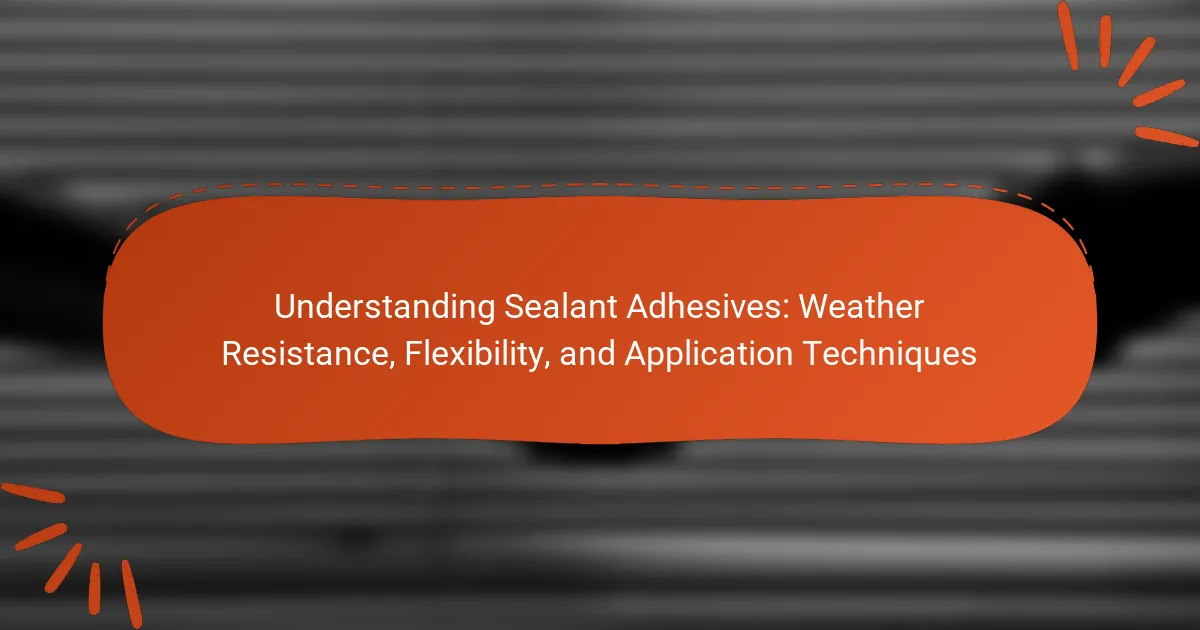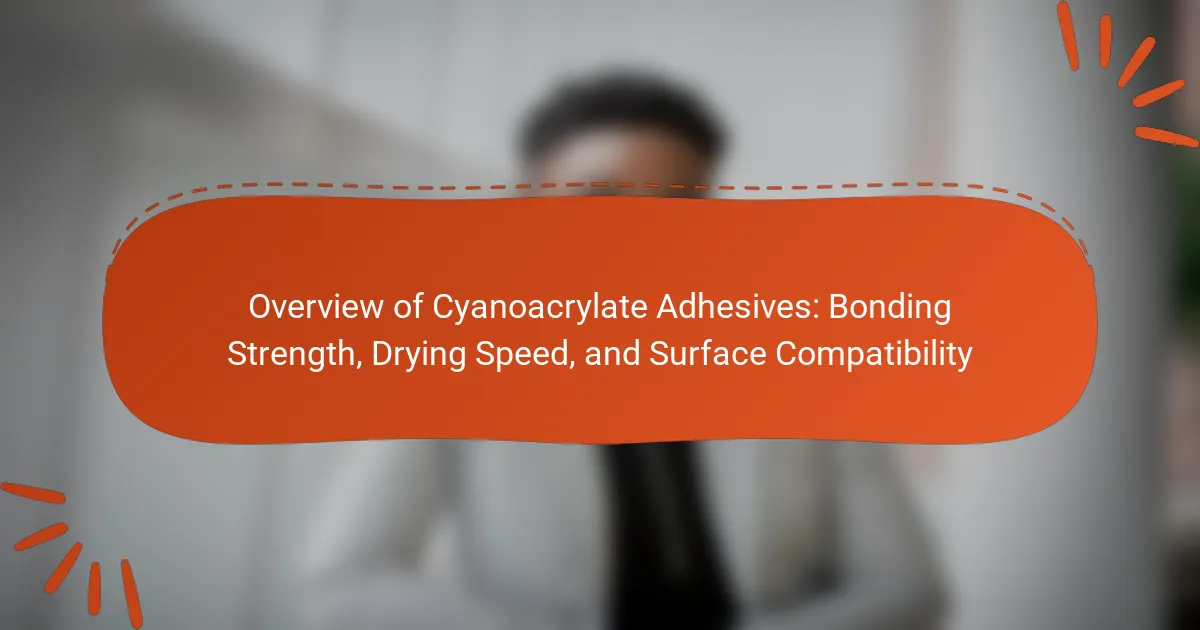Sealant adhesives are specialized materials that bond surfaces while providing a seal against environmental factors such as moisture, air, and dust. They are essential in construction and automotive applications, offering flexibility and durability through various types, including silicone, polyurethane, and acrylic-based sealants. These adhesives maintain their bonding strength under extreme temperatures and conditions, enhancing the longevity of structures and products. Proper application techniques, including surface preparation and the use of appropriate tools, are crucial for maximizing the effectiveness of sealant adhesives, ensuring they perform optimally in diverse environments.

What are Sealant Adhesives?
Sealant adhesives are materials used to bond surfaces while also providing a seal against environmental factors. They combine adhesive properties with sealing capabilities. This dual function makes them ideal for construction and automotive applications. Sealant adhesives can resist moisture, air, and dust infiltration. They are typically used in joints, seams, and gaps. Common types include silicone, polyurethane, and acrylic-based sealants. These materials offer flexibility and durability in various conditions. Their application can enhance the longevity of structures and products.
How do Sealant Adhesives function?
Sealant adhesives function by creating a bond that fills gaps and seals surfaces. They are formulated to adhere to various materials, including metals, plastics, and wood. The bonding process typically involves a chemical reaction that cures the adhesive. This curing can be triggered by moisture, heat, or ultraviolet light. Sealant adhesives provide flexibility, allowing for movement between bonded surfaces without breaking the seal. They also offer weather resistance, protecting against moisture and environmental factors. Many sealant adhesives are designed to withstand extreme temperatures, enhancing durability. Their effectiveness is proven in construction, automotive, and manufacturing applications.
What are the primary components of Sealant Adhesives?
The primary components of sealant adhesives include polymers, fillers, solvents, and additives. Polymers provide the adhesive properties and flexibility. Common types of polymers used are silicone, polyurethane, and acrylic. Fillers enhance the bulk and improve the texture of the sealant. Solvents help in the application process by adjusting viscosity. Additives may include curing agents and stabilizers to improve performance. These components work together to create a sealant adhesive that is effective in various applications.
How do these components contribute to their performance?
Sealant adhesives’ components significantly enhance their performance in various applications. Weather resistance is achieved through specific polymers that resist moisture and temperature fluctuations. These polymers prevent degradation, ensuring long-lasting adhesion under harsh conditions. Flexibility is provided by rubber-like materials that allow movement and expansion without cracking. This flexibility is crucial in environments with temperature changes. Application techniques, such as proper surface preparation and curing methods, optimize adhesion strength. Correct application ensures that the sealant bonds effectively to surfaces, maximizing its protective qualities. Together, these components ensure sealant adhesives perform reliably in diverse conditions and applications.
What are the key attributes of Sealant Adhesives?
Sealant adhesives possess several key attributes. They provide strong adhesion to various substrates. Weather resistance is a critical attribute, ensuring durability in outdoor applications. Flexibility allows them to accommodate movement without cracking. Many sealant adhesives are also water-resistant, preventing moisture intrusion. Some formulations offer UV resistance, protecting against sun damage. Quick curing times enhance their usability in time-sensitive projects. Non-toxicity is important for indoor applications, ensuring safety. Lastly, ease of application contributes to their effectiveness in various settings.
What makes Sealant Adhesives weather resistant?
Sealant adhesives are made weather resistant due to their formulation and chemical properties. They typically contain polymers that provide flexibility and durability. These polymers allow the adhesive to expand and contract with temperature changes. Additionally, sealant adhesives are often designed to repel water and resist moisture [censured]. This characteristic prevents degradation and maintains adhesion strength over time. UV resistance is another critical factor, as it protects the adhesive from sun damage. Furthermore, additives may be included to enhance resistance to mold and mildew. Together, these features ensure that sealant adhesives perform effectively in various weather conditions.
How does flexibility impact the effectiveness of Sealant Adhesives?
Flexibility significantly enhances the effectiveness of sealant adhesives. Flexible sealants can accommodate movement in materials without losing adhesion. This adaptability prevents cracking and failure at joints. For example, in construction, buildings expand and contract due to temperature changes. Sealants that remain flexible can absorb these movements, maintaining a strong bond. Research shows that flexible sealants outperform rigid alternatives in dynamic environments. This quality is essential for long-lasting seals in applications like roofing and window installations. Thus, flexibility directly correlates with the durability and performance of sealant adhesives.
What types of Sealant Adhesives are available?
There are several types of sealant adhesives available. Common types include silicone sealants, polyurethane sealants, and acrylic sealants. Silicone sealants are known for their flexibility and weather resistance. They are often used in construction and automotive applications. Polyurethane sealants provide strong adhesion and durability. They are suitable for both indoor and outdoor use. Acrylic sealants are water-based and easy to clean up. They are typically used for interior applications. Each type has specific properties that make it suitable for different applications.
What are the differences between silicone and polyurethane sealants?
Silicone and polyurethane sealants differ primarily in composition and performance characteristics. Silicone sealants are made from silicon-based compounds. They offer excellent flexibility and weather resistance. Silicone is highly resistant to UV light and extreme temperatures. It is often used in applications exposed to moisture. Polyurethane sealants, on the other hand, are made from polymer compounds. They provide superior adhesion to various substrates. Polyurethane is more durable against abrasion and impacts. However, it is less flexible than silicone. Polyurethane sealants can also be painted over, while silicone typically cannot. These differences influence their suitability for specific applications, such as construction and automotive uses.
How do acrylic sealants compare to other types?
Acrylic sealants are water-based and offer good adhesion to various substrates. They provide flexibility and can accommodate slight movement in joints. Compared to silicone sealants, acrylics are generally easier to paint over. However, they are less resistant to extreme weather conditions than silicones. Polyurethane sealants, while more durable and weather-resistant, can be more challenging to apply and require specific surface preparation. Acrylic sealants cure quickly and are typically less expensive than other types. Their ease of use makes them suitable for interior applications, but they may not perform as well in exterior environments.

How do Sealant Adhesives perform in various conditions?
Sealant adhesives perform effectively in various conditions by maintaining their bonding strength and flexibility. They are designed to withstand temperature fluctuations, moisture, and UV exposure. For instance, silicone-based sealants remain flexible in extreme temperatures, ranging from -60°F to 400°F. Polyurethane sealants provide excellent adhesion to different substrates, even in wet conditions. Epoxy sealants offer superior strength in structural applications but may become brittle in extreme cold. The performance of these adhesives is often tested according to industry standards, such as ASTM C920 for sealants. These standards ensure that sealants meet specific criteria for durability and effectiveness in varying environmental conditions.
What factors affect the weather resistance of Sealant Adhesives?
The weather resistance of sealant adhesives is affected by several factors. These include the chemical composition of the sealant, which determines its durability against environmental elements. The curing process also plays a crucial role; fully cured adhesives typically exhibit better weather resistance. Additionally, the temperature and humidity during application can influence performance. Exposure to UV light can degrade some sealants, affecting their longevity. The presence of fillers and additives can enhance resistance to moisture and temperature fluctuations. Lastly, surface preparation before application is vital for optimal adhesion and weatherproofing.
How does temperature influence Sealant Adhesives’ performance?
Temperature significantly influences sealant adhesives’ performance. High temperatures can accelerate curing time, leading to quicker adhesion. However, excessive heat may also weaken the bond strength over time. Low temperatures can slow down the curing process, resulting in longer set times. Cold conditions can also cause sealants to become brittle, reducing flexibility. Optimal performance typically occurs within a specified temperature range, often between 50°F to 100°F. Deviating from this range can compromise the sealant’s effectiveness. Research indicates that sealants exposed to extreme temperatures may fail prematurely, affecting their longevity and reliability.
What role does humidity play in the effectiveness of Sealant Adhesives?
Humidity significantly impacts the effectiveness of sealant adhesives. High humidity can enhance the curing process of certain moisture-curing adhesives. This is particularly true for polyurethane and silicone sealants, which require moisture to cure effectively. Conversely, low humidity can slow down curing times and may lead to incomplete adhesion. Additionally, excessive moisture can weaken the bond by causing the adhesive to absorb water. Proper humidity levels are crucial for achieving optimal strength and durability in sealant applications. Studies indicate that sealant performance is best when humidity levels are maintained within specific ranges, typically between 40% and 60%.
How does flexibility enhance the application of Sealant Adhesives?
Flexibility enhances the application of sealant adhesives by allowing them to accommodate movement in bonded materials. This characteristic is crucial in environments where temperature fluctuations occur. Sealant adhesives that are flexible can expand and contract without losing adhesion. They maintain a strong bond even under stress, reducing the risk of cracking or peeling. For instance, in construction, flexible sealants prevent water infiltration by adapting to structural shifts. According to industry standards, flexible sealants can withstand significant joint movement, enhancing durability. This adaptability leads to longer-lasting applications in various conditions.
Why is flexibility important for movement in structures?
Flexibility is crucial for movement in structures to accommodate thermal expansion and contraction. As temperatures change, materials expand or shrink. Rigid structures can crack or fail under stress. Flexible components, like sealant adhesives, absorb these movements. They maintain integrity and prevent water infiltration. This is vital in weather resistance, ensuring longevity. Studies show that flexible joints reduce maintenance costs significantly. Thus, flexibility enhances durability and performance in structural applications.
How do different applications require varying levels of flexibility?
Different applications require varying levels of flexibility based on their specific environmental and mechanical demands. For instance, construction sealants must accommodate structural movement, necessitating higher flexibility. In contrast, adhesives used for stationary objects may require less flexibility.
Factors such as temperature fluctuations and substrate movement influence the required flexibility. Sealants in outdoor applications often need to withstand extreme weather conditions. These conditions can cause expansion and contraction, requiring materials that maintain adhesion without cracking.
Research indicates that sealants with higher elongation properties, such as silicone-based products, are essential in dynamic joints. According to the American Society for Testing and Materials (ASTM), sealants should ideally have an elongation of 25% or more for effective performance in such scenarios.
In summary, the level of flexibility required in applications directly correlates with the environmental stresses and the nature of the materials involved.

What are the best application techniques for Sealant Adhesives?
The best application techniques for sealant adhesives include surface preparation, proper application tools, and optimal environmental conditions. Surface preparation involves cleaning the area to remove dirt, dust, and grease. This ensures better adhesion and effectiveness of the sealant. Using the right application tools, such as caulking guns or trowels, allows for precise application and control. Optimal environmental conditions, like appropriate temperature and humidity levels, enhance the curing process. For example, most sealants perform best between 40°F and 100°F. Following these techniques improves the longevity and performance of sealant adhesives.
How can proper surface preparation improve adhesion?
Proper surface preparation improves adhesion by creating a clean and suitable interface for bonding. This process removes contaminants such as dust, grease, and moisture. A clean surface allows adhesives to form stronger molecular bonds. Additionally, surface preparation can involve roughening the surface. Rough surfaces increase the contact area for adhesives, enhancing mechanical interlocking. According to a study published in the Journal of Adhesion Science and Technology, proper surface preparation can increase adhesion strength by up to 50%. This highlights the critical role of preparation in ensuring effective sealant performance.
What steps should be taken for optimal surface preparation?
For optimal surface preparation, clean the surface thoroughly. Remove all dirt, dust, grease, and old sealant residues. Use a suitable cleaner or solvent for effective removal. Ensure the surface is dry before applying any sealant. Inspect for any damage or irregularities that need repair. Sand rough areas to create a smooth surface. Finally, ensure proper temperature and humidity conditions for application. These steps enhance adhesion and ensure the longevity of the sealant.
Why is cleanliness crucial in the application process?
Cleanliness is crucial in the application process of sealant adhesives to ensure proper adhesion. Contaminants like dust, grease, or moisture can weaken the bond. A clean surface promotes optimal contact between the adhesive and the substrate. This leads to enhanced weather resistance and flexibility of the sealant. Studies show that unclean surfaces can reduce adhesion strength by up to 50%. Proper surface preparation is essential for achieving long-lasting results. Therefore, maintaining cleanliness directly impacts the effectiveness of sealant adhesives.
What techniques ensure effective application of Sealant Adhesives?
Proper surface preparation is crucial for effective application of sealant adhesives. Clean surfaces remove contaminants that could hinder adhesion. Ensure surfaces are dry and free of dust, oil, or moisture. Use appropriate tools for application, such as caulking guns or trowels. Maintain a consistent bead size for uniform coverage. Apply sealant at the recommended temperature for optimal curing. Follow manufacturer instructions regarding curing time and environmental conditions. These techniques enhance adhesion and performance of sealant adhesives.
How do caulking guns enhance the application process?
Caulking guns enhance the application process by providing precise control over the flow of sealant. This allows for even application along surfaces, reducing the risk of gaps or excess material. The trigger mechanism enables users to dispense sealant smoothly and consistently. Many caulking guns also feature adjustable pressure settings. This helps accommodate different types of sealants and application needs. Additionally, caulking guns often come with interchangeable nozzles. These nozzles can be customized for various joint sizes and shapes. Overall, these features streamline the application process, improving efficiency and effectiveness.
What tips can improve the precision of sealant application?
To improve the precision of sealant application, ensure proper surface preparation. Clean the area thoroughly to remove dust, grease, or old sealant. Use a high-quality caulking gun for even pressure. Cut the nozzle at a 45-degree angle for better control. Apply the sealant steadily without pauses to maintain a consistent bead. Use painter’s tape to create clean edges and prevent mess. Smooth the bead with a tool or finger for a neat finish. Allow adequate curing time as per the manufacturer’s instructions for optimal performance.
What common issues arise when using Sealant Adhesives?
Common issues when using sealant adhesives include improper adhesion, curing problems, and environmental sensitivity. Improper adhesion occurs when surfaces are not cleaned or prepared correctly. Curing problems arise if the sealant is not applied at the recommended temperature or humidity levels. Environmental sensitivity can lead to premature degradation from UV exposure or moisture. Additionally, sealant adhesives may not bond well with certain materials, leading to failures. These issues can result in leaks or structural damage over time.
How can users prevent sealant failure?
Users can prevent sealant failure by ensuring proper surface preparation. Clean the surfaces thoroughly to remove dust, grease, and moisture. Apply the sealant at the right temperature, ideally between 40°F and 100°F. Use the correct type of sealant for the specific application, as different materials require different formulations. Ensure adequate curing time is observed before exposing the sealant to stress or moisture. Avoid over-application, as excessive sealant can lead to improper adhesion. Regularly inspect and maintain sealed areas to catch any signs of wear early. Following these steps minimizes the risk of sealant failure and enhances durability.
What troubleshooting steps can be taken for common application problems?
Common application problems with sealant adhesives can often be resolved through specific troubleshooting steps. First, check the surface preparation. Ensure surfaces are clean, dry, and free from contaminants. Next, verify the application temperature. Sealants typically perform best within a specific temperature range. If the sealant is not curing properly, examine the humidity levels. High humidity can affect curing times.
Additionally, assess the sealant’s compatibility with the materials being bonded. Incompatible materials can lead to adhesion failures. If the sealant is too thick, consider using a caulking gun for even application. If bubbles appear, this may indicate improper mixing or application technique. Lastly, consult the manufacturer’s guidelines for specific troubleshooting advice related to the product being used.
Sealant adhesives are materials that bond surfaces while providing a seal against environmental factors, making them essential in construction and automotive applications. This article explores the functionality, primary components, and key attributes of sealant adhesives, emphasizing their weather resistance and flexibility. It also details various types of sealants, application techniques, and common issues encountered during use, providing practical insights for effective application and maintenance. Understanding these aspects will enhance the performance and longevity of sealant adhesives in diverse conditions.



